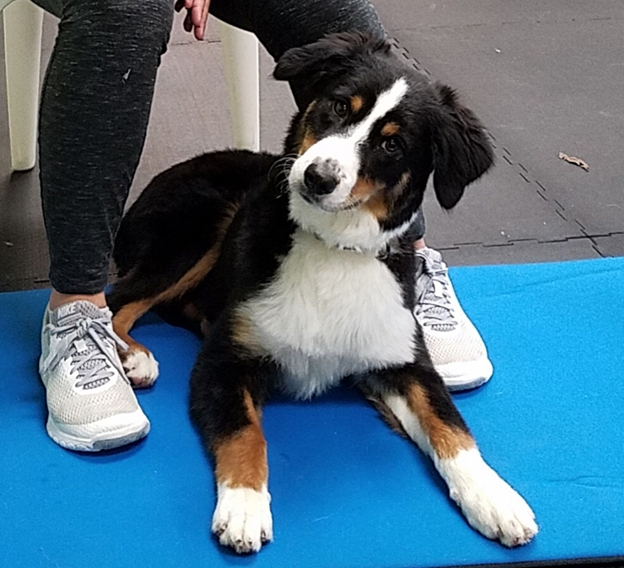Is Your Dog a Scaredy Cat?
You can help change your dog’s fearful behavior.
A couple of years ago, I worked with an adorable 7-month old Australian Shepherd, Bear. His concerned mom brought him to me because he was very fearful of strangers and would bark, growl and lunge when they got too close.
Remove social pressure
When Brittany and Bear arrived she followed the instructions I had previously given her. I was already sitting in the training room and I did not get up to greet either of them. I wanted to remove as much social pressure from Bear as possible and sitting quietly helped. The Brittany sat down across from me and we began to talk about Bear. She let Bear off leash to explore the room. I noticed Bear’s fearfulness immediately. He stretched to inspect items around the room, lacking the confidence to get too close to unfamiliar smells and items. Initially, he mostly avoided me but any time he came anywhere near I tossed high-value food (chicken morsels) even further away from me. I did not look at or speak to Bear initially at all. I just kept ignoring him and tossing chicken at a safe distance away from me. I was glad to see that he was able to eat because many fearful dogs will not.
Eventually, he began to relax. He chose to move closer to me, and one time put a foot on my lap to encourage me to give him more chicken. I calmly gave him a morsel but did not pet him. Giving him time, not applying any pressure to him by avoiding interacting with him, associating myself with something desirable, and keeping him at a distance all allowed him the time and space to feel safer. I was able to begin working with him on a limited basis near his mom as we worked on strategies and behavioral tools for changing his behavior.
Can you reinforce fear?
Many pet parents understandably get confused about giving a fearful dog food or comforting them. Isn’t that reinforcing the behavior? Teaching your dog to feel safer or associating something scary with something good does not strengthen scared feelings, it helps change them. Fear does not feel good and comforting your dog is not going to make your dog want to be more fearful. Even high-value food or other reinforcers will not remove the instinct to protect oneself in a scary situation.
Create a positive emotional response
You can, however, use something of value, such as treats, to change a dog’s attitude toward the fearful situation. Let’s say you are really afraid of snakes. If there is a snake 5 feet in front of you, my comforting you is not going to make you more fearful of the snake. But if I take you far enough away from the snake so that you were still aware of it but feeling calm and I began handing you $50 bills you will eventually become more interested in the money than in the snake. At that safe distance, you might begin to associate the snake with something super good and you would look forward to seeing it. This simplified explanation of classical counterconditioning and desensitization can work for a dog’s fears too.
I used tasty food with Bear to make him associate me, an initially scary person, with something good, but it was done in a way that respected his need for space and the time to safely form his own opinion that I was not scary.
The photo at the top is of adorable Bear toward the end of the session looking less worried than he was at the beginning.
Here are some tips to help your fearful dog.
- Understanding what your dog is afraid of is important in the process of helping him change how he feels.
- Don’t punish your dog for being fearful. You need to change his or her feeling and punishing your dog may make it worse. You can punish away a growl but it will not change the underlying emotion. If your dog does not have a growl, the next escalation of fear might be a bite. Growling is information and indicates your dog’s discomfort with something happening. Quickly assess the situation and figure out how to change it.
- Fear can take many forms including, growling or lunging (fight), cowering, hiding or trying to run away (flight), or shutting down and not being able to respond at all (freeze). Sometimes anxiety can cause hyperactivity such as a dog zooming around an agility field and not listening at all (fidget). Familiarize yourself with your dog’s body language that indicates he or she is afraid.
- Try not to get anxious yourself; fear can be contagious. That means, for instance, no tightening up or jerking the leash.
- Remove your scared dog from the situation that is causing the fear. You can create distance; limit his visual exposure such as using body blocking or a natural barrier such as a hedge or car; or change his line of sight. Pushing your dog to face his fear will not make him feel better (would sticking a snake in the face of a snake-phobic person work?) and may adversely affect your trust relationship with your dog.
- Give your dog something else to do when he sees something (at a safe distance) he is afraid of, such as scattering high-value treats in the grass and having your dog search for them. We have several effective behavioral tools we use to help a fearful dog to modify his behavior.
- Work with a knowledgeable trainer or behaviorist to help change your dog’s behavior. Most importantly, have empathy and patience because true behavior change takes time. Check out the Reactive Dog Program: From Anxious to Zensational to help your dog.

